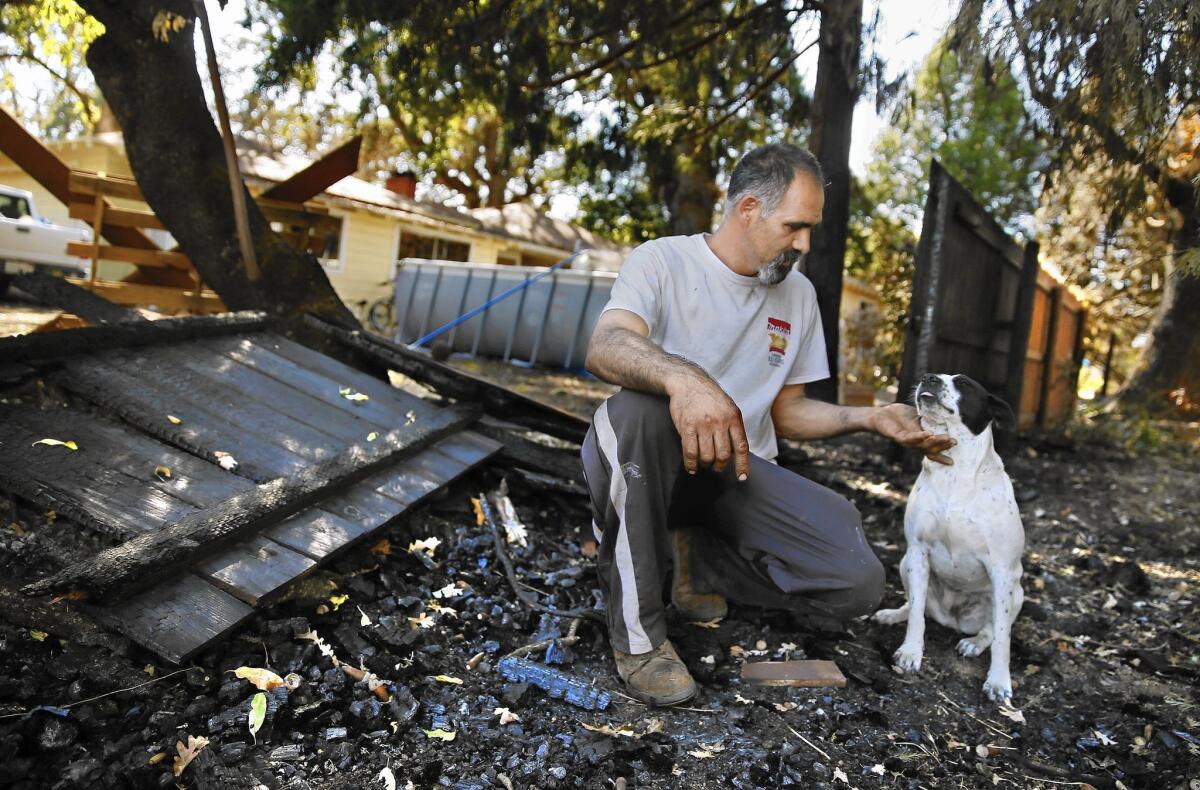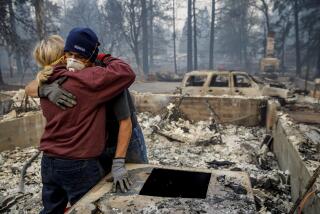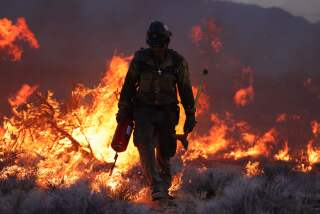How the Valley fire exploded into one of the worst in California history

Joni Prather was tending store at the Yogi Bear campground outside this tiny mountain town when she saw the puff of smoke.
“Grass fire,” she thought.
------------
FOR THE RECORD: In the Sept. 20 California section, an article about the evolution of Northern California’s Valley fire included a statement by a Middletown resident who said he watched a patrolling law enforcement officer drive by and shoot his dog. The resident now says that he did not witness the shooting. The dog is recovering at UC Davis veterinary school.
------------
The smoke was rising about a half mile upwind, created by a small fire that had somehow ignited — the cause is still under investigation — burned through the corner of a utility shed, and crept across the brown lawn in front of a large house.
Prather watched the smoke rise over the trees as, half a mile away, the flames climbed alongside a steep driveway to a neighbor’s vacation house.
When the smoke turned black, she told herself: “It got a structure.”
She was right.
Consuming that house appears to be what gave the Valley fire the critical mass of heat and energy it needed to become a lethal monster. Black scorch marks high up the Ponderosa pines show the reach of the flames. Intense heat from the burning house flash-dried the leaves of a nearby oak tree.
Here in the Mayacamas Mountains that hover above Clear Lake, 100 miles north of San Francisco, California’s drought has been going on for seven years. Pine beetles have attacked the stressed gray pines, leaving dead timber standing. A century of fire suppression has built up thick undergrowth.
Meanwhile, city dwellers’ desire for a rustic cottage in the woods — often tucked away on a twisting road with only one way out — has added to the danger.
When a freakish jet of wind howled up Putah Creek on Sept. 12, it whipped the Valley fire into a conflagration that rocketed it into the ranks of the worst in California history. The wind sent embers as far as a mile to kindle new fires that spawned new embers.
Winds rushed through the valley at speeds of some 60 mph.
Within minutes of the fire’s start, a helicopter, always standing at the ready during fire season, dropped off a Cal Fire captain and his three crew members to corral the spreading blaze by hand, and took off to fetch water from a nearby lake.
See the most-read stories this hour >>
The four firefighters immediately ran into trouble. Scorch marks show the fire was high in the tops of trees when it climbed the now-black knob where they had tried to make a stand. They deployed their fire shelters and radioed for help, said Jim Comisky, a retired California Department of Forestry and Fire Protection battalion chief who lives nearby.
Comisky said Jim Wright, a Cal Fire division chief who also lives nearby, heard the distress call and drove into the fire to get the men, pushing them into his pickup.
Cal Fire officials confirmed that Wright rescued Capt. Pat Ward and firefighters Niko Matteoli, Richard Wriff, and Logan Pridmore. They were seriously burned and remain hospitalized.
Within 10 minutes, two helicopters were dropping water, and in 15 more, DC-10 air tankers were painting the valley and the overlook to the east, on which stood an old-style family camp resort, Hoberg’s, with pink fire retardant.
------------
FOR THE RECORD: A previous version of this article referred to 707 jets. The air tankers were DC-10s.
------------
It wasn’t enough.
As the fire grew at alarming speed, Prather kept vigil at the campground filled with summer visitors.
Meanwhile, her husband and six brothers, third-generation natives of Lake County and many of them retired firefighters for the state, rolled into action.
First they alerted neighbors in the valley and on the opposing ridge, then they revved up brother Darryl’s Cat D4 bulldozer and two green 1970s Chevy pickups that they had rigged into pumper trucks with 125-gallon tanks. Others brought more equipment.
Their goal: save Seigler Mountain, the community of Loch Lomond beneath it, and the radio repeater tower that broadcast the Lake County Sheriff’s Department emergency traffic into the disaster zone.
Even as mandatory evacuation orders kicked in and roadblocks and patrols sought to keep everyone out, the sheriff’s office tried to secure safe passage for the Prather boys — so named because they once formed a band that opened for the Doobie Brothers.
Family members slipped through the roadblocks to deliver supplies. A niece and her boyfriend, a San Francisco firefighter, joined the brothers, and together they worked in shifts. With the dozer, chain saws and hand tools, they cut fire lines and patrolled them, acting quickly to put out spot fires.
Many residents had received automated calls on Lake County’s 911 system to get out of the way of the fast-advancing fire, but phone lines went out and others had little warning. The roads out were insufficient for the traffic, and cars crashed.
The skeletons of vehicles littered Highway 29 near Middletown.
Roberto Rodriguez was picking grapes in the vineyards north of Middletown with his co-workers as the fire started to build. When he got into town, he saw the fire coming down the valley, pushed by a wind.
“It was bouncing off the canyons,” he said, twirling his fingers in his palm to demonstrate. “No, that is not right. It was dancing. Whirling.”
Firefighters call them “firenados.” A fire draws so much oxygen that the racing air creates an upward wind, and builds a tall cloud, a pyrocumulus. These spread in all directions, and are so complex that computer models of fire behavior cannot forecast their path.
Sooner than seemed possible, the fire burned Rodriguez’s house in Middletown.
Francisco Cervantes did not think he needed to leave Middletown for a fire that started 10 miles away, but by nightfall, he regretted his decision to stay. He stuck it out with a garden hose, and when a lack of power shut down his water pump, he was left throwing buckets of water from his neighbor’s swimming pool.
His fence caught fire, and he took a saw to it.
The neighbor’s big oak tree caught fire, and Cervantes ran around with a shovel, smothering the fire with dirt.
At dawn, he sat with a shocked look on his drawn face, two dogs lazing on the still-green grass in his front lawn, surrounded by destruction.
“I was running around, here, there,” he said. He saved his house, but it had been a nightmare he was not certain he would survive. “I will never stay again.”
Also still standing in the heaviest hit part of Middletown is the veterinary hospital built over 10 years by Dr. Jeff Smith.
He was out of town when the Valley fire started, and he drove in, not out. His employees had evacuated at the last minute Saturday night, throwing crates crowded with dogs and cats into their cars pell mell.
When Smith arrived Sunday morning, he found a horse and two goats in the paddock and the few dogs that could not be moved. The hospital was spared, but on every side, it was black.
Over the days, a stream of firefighters, volunteers and others brought in burned cats — lots of cats — and dogs, chickens, burros, parrots and even a bucket of goldfish.
The one that bothers Smith is Cervantes’ dog, brought in alive but bleeding from large wounds.
After the fire was over, someone had shot the dog. Twice.
Cervantes told a reporter he watched a patrolling law enforcement officer drive by and shoot the dog.
Read more about California wildfires >>
Smith said he could still hear Cervantes’ pained bewilderment: “‘I don’t understand it ... I saved my neighbor’s house. I just don’t understand,’” Smith said, his own voice shaking with exhaustion and emotion. Veterinarians triaged the dog and sent it to UC Davis, where it will undergo extensive reconstructive surgery, at no cost.
Up by Cobb, where the blaze began, flames kept returning, flaring up in areas that had been hopped over in the first run. Houses that had been spared earlier were again endangered.
Over five days, Cal Fire crews were aided by an army of firefighters from departments across the state, as well as Colorado and Canada, who finally had been released from other California fires. They fought the blaze in hit-and-run skirmishes.
By Friday night, 442 engines, 72 water tenders, 22 helicopters, two air tankers, 94 hand crews, 68 dozers and a total of 4,227 personnel had arrived. The fire had forced some 8,000 residents in a 100-square mile area to flee through just four main arteries. Three bodies of those who couldn’t escape have been found, and cadaver dogs are searching for more. The count of destroyed houses is just beginning, but state fire officials estimate 585 as a starting point.
For their part, the Prather boys prevailed, and on Thursday night, when the worst of the nightmare was over, the family gathered in one of their cabins on Seigler Mountain for what had the feel of a celebratory dinner.
Some were still ragged. The fare included blackened hot dogs.
ALSO
California Republican candidates for U.S. Senate tout unity at party convention
Jackie Collins dies at 77; author of ‘Hollywood Wives’
California Republicans set to soften stance on immigrants in the country illegally
More to Read
Start your day right
Sign up for Essential California for news, features and recommendations from the L.A. Times and beyond in your inbox six days a week.
You may occasionally receive promotional content from the Los Angeles Times.







